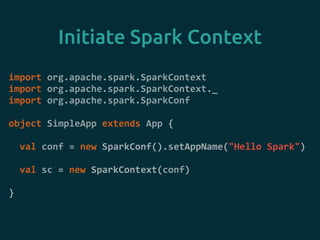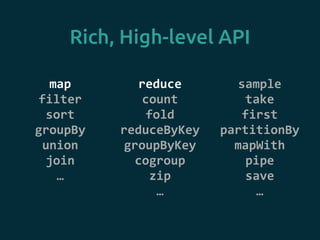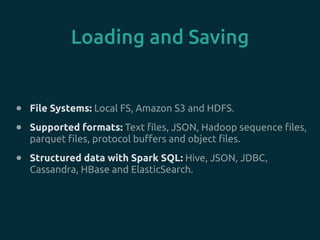Introduction to Apache Spark
- 1. An Introduction to Apache Spark Anastasios Skarlatidis @anskarl Software Engineer/Researcher IIT, NCSR "Demokritos"
- 2. • Part I: Getting to know Spark • Part II: Basic programming • Part III: Spark under the hood • Part IV: Advanced features Outline
- 3. Part I: Getting to know Spark
- 4. Spark in a Nutshell • General cluster computing platform: • Distributed in-memory computational framework. • SQL, Machine Learning, Stream Processing, etc. • Easy to use, powerful, high-level API: • Scala, Java, Python and R.
- 5. Unified Stack Spark SQL Spark Streaming (real-time processing) MLlib (Machine Learning) GraphX (graph processing) Spark Core Standalone Scheduler YARN Mesos
- 6. High Performance • In-memory cluster computing. • Ideal for iterative algorithms. • Faster than Hadoop: • 10x on disk. • 100x in memory.
- 7. Brief History • Originally developed in 2009, UC Berkeley AMP Lab. • Open-sourced in 2010. • As of 2014, Spark is a top-level Apache project. • Fastest open-source engine for sorting 100 ΤΒ: • Won the 2014 Daytona GraySort contest. • Throughput: 4.27 TB/min
- 8. Who uses Spark, and for what? A. Data Scientists: • Analyze and model data. • Data transformations and prototyping. • Statistics and Machine Learning. B. Software Engineers: • Implement production data processing systems. • Require a reasonable API for distributed processing. • Reliable, high performance, easy to monitor platform.
- 9. Resilient Distributed Dataset RDD is an immutable and partitioned collection: • Resilient: it can be recreated, when data in memory is lost. • Distributed: stored in memory across the cluster. • Dataset: data that comes from file or created programmatically. RDD partitions
- 10. Resilient Distributed Datasets • Feels like coding using typical Scala collections. • RDD can be build: 1. Directly from a datasource (e.g., text file, HDFS, etc.), 2. or by applying a transformation to another RDD(s). • Main features: • RDDs are computed lazily. • Automatically rebuild on failure. • Persistence for reuse (RAM and/or disk).
- 12. Spark Shell $ cd spark $ ./bin/spark-‐shell Spark assembly has been built with Hive, including Datanucleus jars on classpath Welcome to ____ __ / __/__ ___ _____/ /__ _ / _ / _ `/ __/ '_/ /___/ .__/_,_/_/ /_/_ version 1.2.1 /_/ Using Scala version 2.10.4 (Java HotSpot(TM) 64-‐Bit Server VM, Java 1.7.0_71) Type in expressions to have them evaluated. Type :help for more information. Spark context available as sc. scala>
- 13. Standalone Applications Sbt: "org.apache.spark" %% "spark-‐core" % "1.2.1" Maven: groupId: org.apache.spark artifactId: spark-‐core_2.10 version: 1.2.1
- 14. Initiate Spark Context import org.apache.spark.SparkContext import org.apache.spark.SparkContext._ import org.apache.spark.SparkConf object SimpleApp extends App { val conf = new SparkConf().setAppName("Hello Spark") val sc = new SparkContext(conf) }
- 15. Rich, High-level API map filter sort groupBy union join … reduce count fold reduceByKey groupByKey cogroup zip … sample take first partitionBy mapWith pipe save …
- 16. Rich, High-level API map filter sort groupBy union join … reduce count fold reduceByKey groupByKey cogroup zip … sample take first partitionBy mapWith pipe save …
- 17. Loading and Saving • File Systems: Local FS, Amazon S3 and HDFS. • Supported formats: Text files, JSON, Hadoop sequence files, parquet files, protocol buffers and object files. • Structured data with Spark SQL: Hive, JSON, JDBC, Cassandra, HBase and ElasticSearch.
- 18. Create RDDs // sc: SparkContext instance // Scala List to RDD val rdd0 = sc.parallelize(List(1, 2, 3, 4)) // Load lines of a text file val rdd1 = sc.textFile("path/to/filename.txt") // Load a file from HDFS val rdd2 = sc.hadoopFile("hdfs://master:port/path") // Load lines of a compressed text file val rdd3 = sc.textFile("file:///path/to/compressedText.gz") // Load lines of multiple files val rdd4 = sc.textFile("s3n://log-‐files/2014/*.log")
- 19. RDD Operations 1. Transformations: define new RDDs based on current one, e.g., filter, map, reduce, groupBy, etc. RDD New RDD 2. Actions: return values, e.g., count, sum, collect, etc. value RDD
- 20. Transformations (I): basics val nums = sc.parallelize(List(1, 2, 3)) // Pass each element through a function val squares = nums.map(x => x * x) //{1, 4, 9} // Keep elements passing a predicate val even = squares.filter(_ % 2 == 0) //{4} // Map each element to zero or more others val mn = nums.flatMap(x => 1 to x) //{1, 1, 2, 1, 2, 3}
- 21. Transformations (I): illustrated nums squares ParallelCollectionRDD even mn nums.flatMap(x => 1 to x) squares.filter(_ % 2 == 0) MappedRDD FilteredRDD nums.map(x => x * x) FlatMappedRDD
- 22. Transformations (II): key - value val pets = sc.parallelize(List(("cat", 1), ("dog", 1), ("cat", 2))) ValueKey pets.filter{case (k, v) => k == "cat"} // {(cat,1), (cat,2)} pets.map{case (k, v) => (k, v + 1)} // {(cat,2), (dog,2), (cat,3)} pets.mapValues(v => v + 1) // {(cat,2), (dog,2), (cat,3)}
- 23. Transformations (II): key - value // Aggregation pets.reduceByKey((l, r) => l + r) //{(cat,3), (dog,1)} // Grouping pets.groupByKey() //{(cat, Seq(1, 2)), (dog, Seq(1)} // Sorting pets.sortByKey() //{(cat, 1), (cat, 2), (dog, 1)} val pets = sc.parallelize(List(("cat", 1), ("dog", 1), ("cat", 2))) ValueKey
- 24. Transformations (III): key - value //RDD[(URL, page_name)] tuples val names = sc.textFile("names.txt").map(…)… //RDD[(URL, visit_counts)] tuples val visits = sc.textFile("counts.txt").map(…)… //RDD[(URL, (visit counts, page name))] val joined = visits.join(names)
- 25. Basics: Actions val nums = sc.parallelize(List(1, 2, 3)) // Count number of elements nums.count() // = 3 // Merge with an associative function nums.reduce((l, r) => l + r) // = 6 // Write elements to a text file nums.saveAsTextFile("path/to/filename.txt")
- 27. Part III: Spark under the hood
- 28. 1. Job: work required to compute an RDD. 2. Each job is divided to stages. 3. Task: • Unit of work within a stage • Corresponds to one RDD partition. Units of Execution Model Task 0 Job Stage 0 …Task 1 Task 0 Stage 1 …Task 1 …
- 29. Execution Model Driver Program SparkContext Worker Node Task Task Executor Worker Node Task Task Executorval lines = sc.textFile("README.md") val countedLines = lines.count()
- 30. Example: word count val lines = sc.textFile("hamlet.txt") val counts = lines.flatMap(_.split(" ")) // (a) .map(word => (word, 1)) // (b) .reduceByKey(_ + _) // (c) "to be or" "not to be" (a) "to" "be" "or" "not" "to" "be" ("to", 1) ("be", 1) ("or", 1) ("not", 1) ("to", 1) ("be", 1) (b) ("be", 2) ("not", 1) ("or", 1) ("to", 2) (c) to be or not to be
- 31. 12: val lines = sc.textFile("hamlet.txt") // HadoopRDD[0], MappedRDD[1] 13: 14: val counts = lines.flatMap(_.split(" ")) // FlatMappedRDD[2] 15: .map(word => (word, 1)) // MappedRDD[3] 16: .reduceByKey(_ + _) // ShuffledRDD[4] 17: 18: counts.toDebugString res0: String = (2) ShuffledRDD[4] at reduceByKey at <console>:16 [] +-‐(2) MappedRDD[3] at map at <console>:15 [] | FlatMappedRDD[2] at flatMap at <console>:14 [] | hamlet.txt MappedRDD[1] at textFile at <console>:12 [] | hamlet.txt HadoopRDD[0] at textFile at <console>:12 [] Visualize an RDD
- 32. Lineage Graph val lines = sc.textFile("hamlet.txt") // MappedRDD[1], HadoopRDD[0] val counts = lines.flatMap(_.split(" ")) // FlatMappedRDD[2] .map(word => (word, 1)) // MappedRDD[3] .reduceByKey(_ + _) // ShuffledRDD[4] [0] [1] [2] [3] [4] HadoopRDD MappedRDD FlatMappedRDD MappedRDD ShuffledRDD
- 33. Lineage Graph val lines = sc.textFile("hamlet.txt") // MappedRDD[1], HadoopRDD[0] val counts = lines.flatMap(_.split(" ")) // FlatMappedRDD[2] .map(word => (word, 1)) // MappedRDD[3] .reduceByKey(_ + _) // ShuffledRDD[4] HadoopRDD MappedRDD FlatMappedRDD MappedRDD ShuffledRDD
- 34. HadoopRDD MappedRDD FlatMappedRDD MappedRDD ShuffledRDD Execution Plan val lines = sc.textFile("hamlet.txt") // MappedRDD[1], HadoopRDD[0] val counts = lines.flatMap(_.split(" ")) // FlatMappedRDD[2] .map(word => (word, 1)) // MappedRDD[3] .reduceByKey(_ + _) // ShuffledRDD[4] Stage 1 Stage 2 pipelining
- 36. Persistence • When we use the same RDD multiple times: • Spark will recompute the RDD. • Expensive to iterative algorithms. • Spark can persist RDDs, avoiding recomputations.
- 37. Levels of persistence val result = input.map(expensiveComputation) result.persist(LEVEL) LEVEL Space Consumption CPU time In memory On disk MEMORY_ONLY (default) High Low Y N MEMORY_ONLY_SER Low High Y N MEMORY_AND_DISK High Medium Some Some MEMORY_AND_DISK_SER Low High Some Some DISK_ONLY Low High N Y
- 38. Persistence Behaviour • Each node will store its computed partition. • In case of a failure, Spark recomputes the missing partitions. • Least Recently Used cache policy: • Memory-only: recompute partitions. • Memory-and-disk: recompute and write to disk. • Manually remove from cache: unpersist()
- 39. Shared Variables 1. Accumulators: aggregate values from worker nodes back to the driver program. 2. Broadcast variables: distribute values to all worker nodes.
- 40. Accumulator Example val input = sc.textFile("input.txt") val sum = sc.accumulator(0) val count = sc.accumulator(0) input .filter(line => line.size > 0) .flatMap(line => line.split(" ")) .map(word => word.size) .foreach{ size => sum += size // increment accumulator count += 1 // increment accumulator } val average = sum.value.toDouble / count.value driver only initialize the accumulators
- 41. • Safe: Updates inside actions will only applied once. • Unsafe: Updates inside transformation may applied more than once!!! Accumulators and Fault Tolerance
- 42. Broadcast Variables • Closures and the variables they use are send separately to each task. • We may want to share some variable (e.g., a Map) across tasks/operations. • This can efficiently done with broadcast variables.
- 43. Example without broadcast variables // RDD[(String, String)] val names = … //load (URL, page name) tuples // RDD[(String, Int)] val visits = … //load (URL, visit counts) tuples // Map[String, String] val pageMap = names.collect.toMap val joined = visits.map{ case (url, counts) => (url, (pageMap(url), counts)) } pageMap is sent along with every task
- 44. Example with broadcast variables // RDD[(String, String)] val names = … //load (URL, page name) tuples // RDD[(String, Int)] val visits = … //load (URL, visit counts) tuples // Map[String, String] val pageMap = names.collect.toMap val bcMap = sc.broadcast(pageMap) val joined = visits.map{ case (url, counts) => (url, (bcMap.value(url), counts)) } Broadcast variable pageMap is sent only to each node once
- 46. Appendix
- 49. Staging groupBy map filter join Stage 1 Stage 2 Stage 3
























![Transformations (III): key - value
//RDD[(URL,
page_name)]
tuples
val
names
=
sc.textFile("names.txt").map(…)…
//RDD[(URL,
visit_counts)]
tuples
val
visits
=
sc.textFile("counts.txt").map(…)…
//RDD[(URL,
(visit
counts,
page
name))]
val
joined
=
visits.join(names)](https://image.slidesharecdn.com/intro2spark-shug-150305024939-conversion-gate01/85/Introduction-to-Apache-Spark-24-320.jpg)






![12:
val
lines
=
sc.textFile("hamlet.txt")
//
HadoopRDD[0],
MappedRDD[1]
13:
14:
val
counts
=
lines.flatMap(_.split("
"))
//
FlatMappedRDD[2]
15:
.map(word
=>
(word,
1))
//
MappedRDD[3]
16:
.reduceByKey(_
+
_)
//
ShuffledRDD[4]
17:
18:
counts.toDebugString
res0:
String
=
(2)
ShuffledRDD[4]
at
reduceByKey
at
<console>:16
[]
+-‐(2)
MappedRDD[3]
at
map
at
<console>:15
[]
|
FlatMappedRDD[2]
at
flatMap
at
<console>:14
[]
|
hamlet.txt
MappedRDD[1]
at
textFile
at
<console>:12
[]
|
hamlet.txt
HadoopRDD[0]
at
textFile
at
<console>:12
[]
Visualize an RDD](https://image.slidesharecdn.com/intro2spark-shug-150305024939-conversion-gate01/85/Introduction-to-Apache-Spark-31-320.jpg)
![Lineage Graph
val
lines
=
sc.textFile("hamlet.txt")
//
MappedRDD[1],
HadoopRDD[0]
val
counts
=
lines.flatMap(_.split("
"))
//
FlatMappedRDD[2]
.map(word
=>
(word,
1))
//
MappedRDD[3]
.reduceByKey(_
+
_)
//
ShuffledRDD[4]
[0] [1] [2] [3] [4]
HadoopRDD MappedRDD FlatMappedRDD MappedRDD ShuffledRDD](https://image.slidesharecdn.com/intro2spark-shug-150305024939-conversion-gate01/85/Introduction-to-Apache-Spark-32-320.jpg)
![Lineage Graph
val
lines
=
sc.textFile("hamlet.txt")
//
MappedRDD[1],
HadoopRDD[0]
val
counts
=
lines.flatMap(_.split("
"))
//
FlatMappedRDD[2]
.map(word
=>
(word,
1))
//
MappedRDD[3]
.reduceByKey(_
+
_)
//
ShuffledRDD[4]
HadoopRDD MappedRDD FlatMappedRDD MappedRDD ShuffledRDD](https://image.slidesharecdn.com/intro2spark-shug-150305024939-conversion-gate01/85/Introduction-to-Apache-Spark-33-320.jpg)
![HadoopRDD MappedRDD FlatMappedRDD MappedRDD ShuffledRDD
Execution Plan
val
lines
=
sc.textFile("hamlet.txt")
//
MappedRDD[1],
HadoopRDD[0]
val
counts
=
lines.flatMap(_.split("
"))
//
FlatMappedRDD[2]
.map(word
=>
(word,
1))
//
MappedRDD[3]
.reduceByKey(_
+
_)
//
ShuffledRDD[4]
Stage 1 Stage 2
pipelining](https://image.slidesharecdn.com/intro2spark-shug-150305024939-conversion-gate01/85/Introduction-to-Apache-Spark-34-320.jpg)








![Example without
broadcast variables
//
RDD[(String,
String)]
val
names
=
…
//load
(URL,
page
name)
tuples
//
RDD[(String,
Int)]
val
visits
=
…
//load
(URL,
visit
counts)
tuples
//
Map[String,
String]
val
pageMap
=
names.collect.toMap
val
joined
=
visits.map{
case
(url,
counts)
=>
(url,
(pageMap(url),
counts))
}
pageMap
is
sent
along
with
every
task](https://image.slidesharecdn.com/intro2spark-shug-150305024939-conversion-gate01/85/Introduction-to-Apache-Spark-43-320.jpg)
![Example with
broadcast variables
//
RDD[(String,
String)]
val
names
=
…
//load
(URL,
page
name)
tuples
//
RDD[(String,
Int)]
val
visits
=
…
//load
(URL,
visit
counts)
tuples
//
Map[String,
String]
val
pageMap
=
names.collect.toMap
val
bcMap
=
sc.broadcast(pageMap)
val
joined
=
visits.map{
case
(url,
counts)
=>
(url,
(bcMap.value(url),
counts))
}
Broadcast variable
pageMap
is
sent
only
to
each
node
once](https://image.slidesharecdn.com/intro2spark-shug-150305024939-conversion-gate01/85/Introduction-to-Apache-Spark-44-320.jpg)



























































































